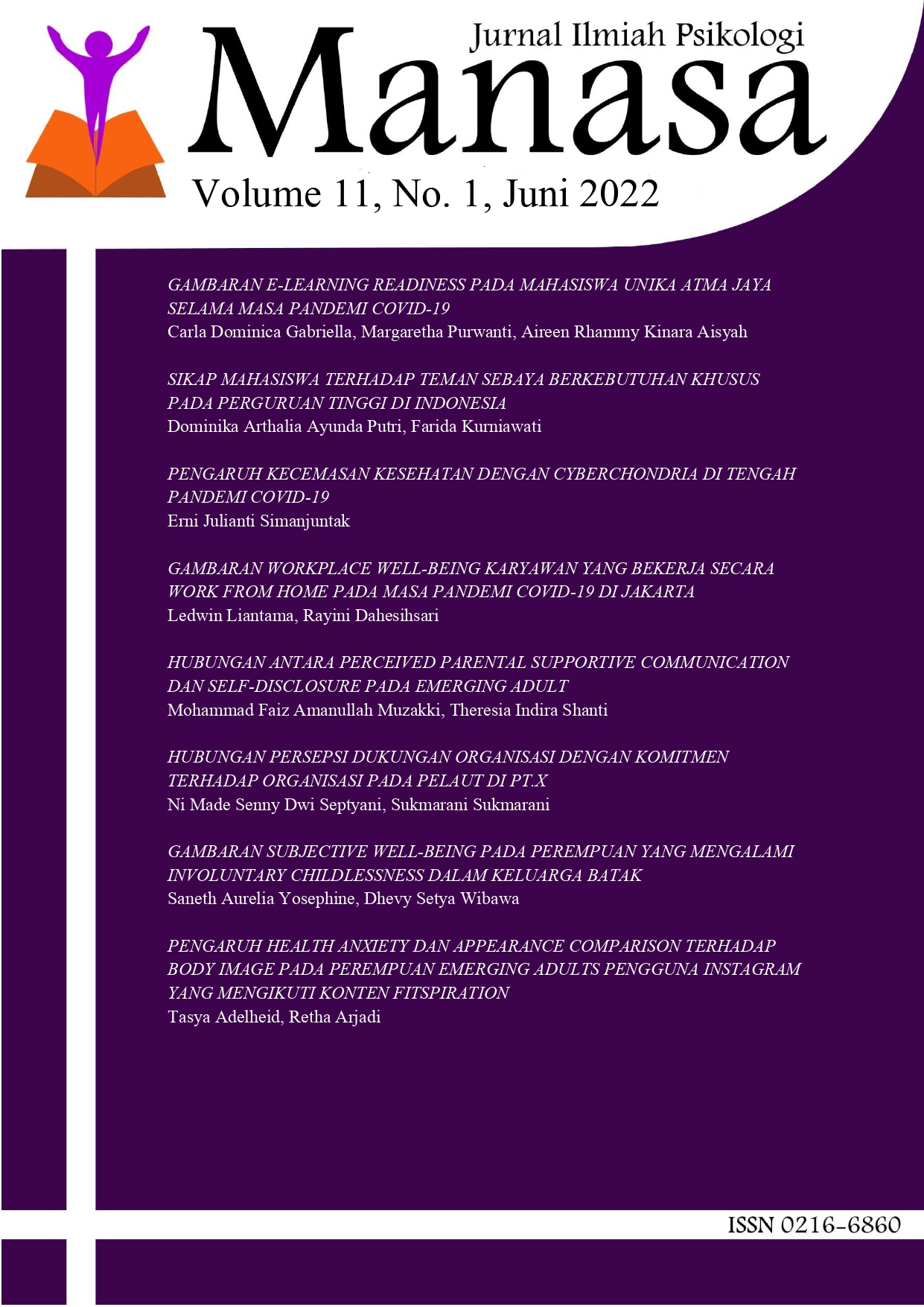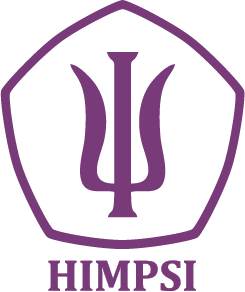Gambaran Workplace Well-Being Karyawan yang Bekerja Secara Work From Home Pada Masa Pandemi Covid-19 di Jakarta
DOI:
https://doi.org/10.25170/manasa.v11i1.3210Keywords:
workplace well-being, work from home, pandemic covid-19Abstract
Abstract
COVID-19 Pandemic that has occurred throughout the world has had a significant impact on the working place while the government-imposed employees to work from home. This study aimed to describe employees' workplace well-being while working from home during the Pandemic. Data was collected from 200 participants working from home during the Pandemic, using 38 items of workplace well-being (WWB) questionnaire, consisting of extrinsic and intrinsic dimensions. Descriptive statistics were applied for data analyses. The findings showed that most of the participants had a WWB in the above-average category for both intrinsic and extrinsic dimensions of WWB. The findings indicated that even though working from home, participants still maintained their well-being at work, potentially leading to productivity. However, on the intrinsic dimension, independence in work was still considered low compared to other aspects of WWB. While working from home, there was a high demand for working independently, which might cause pressure for the participants. The ability to work independently needs to improve to meet the demand. In addition, there was a significant difference in the level of WWB on the different age groups, tenure, and job levels. The older the participants with more extended working experience and a higher level of job tend to reach a higher level of WWB.
Keywords: Workplace Well-Being, Work From Home, Pandemic Covid-19
Abstrak
Pangemi covid-19 yang terjadi di dunia memberikan dampak yang signifikan di tempat kerja ketika pemerintah mengharuskan karyawan untuk bekerja dari rumah. Penelitian ini bertujuan untuk menggambarkan workplace well-being karyawan ketika bekerja dari rumah selama masa pandemi. Data penelitian dikumpulkan dari 200 partisipan yang bekerja dari rumah selama pandemi, menggunakan kuesioner workplace well-being (WWB) yang terdiri dari 38 butir, yang mencakup dimensi ekstrinsik dan intrinsik. Analisis data dilakukan dengan teknik statistik deskriptif. Temuan dari penelitian ini menunjukan sebagian besar partisipan memiliki WWB dengan kategori di atas rata-rata untuk dimensi intrinsik dan ekstrinsik. Temuan dari penelitian ini juga mengindikasikan walaupun dengan bekerja dari rumah, partisipan tetap menjaga well-being dalam bekerja, yang mana hal ini berpotensi untuk lebih produktif dalam bekerja. Namun, pada dimensi intrinsik, kemandirian dalam bekerja cenderung rendah jika dibandingkan dengan aspek lain pada WWB. Ketika bekerja dari rumah, tentunya mengharuskan karyawan untuk lebih mandiri dalam bekerja, yang mungkin hal ini dapat memberikan tekanan kepada partisipan. Kemampuan untuk mandiri dalam bekerja perlu dikembangkan untuk bisa sesuai dengan tuntutan. Sebagai tambahan, terdapat perbedaan yang signifikan pada tingkat WWB pada kelompok usia, masa kerja, dan tingkat jabatan. Partisipan yang usianya lebih tua, memiliki pengalaman kerja yang lebih banyak, dan memiliki jabatan yang tinggi cenderung memiliki WWB yang lebih tinggi.
Kata Kunci: Workplace Well-Being, Work From Home, Pandemic Covid-19
References
Aryan, R. & Kathuria, D. (2017). Psychological wellbeing at workplace: an analytical study on it sector. International Journals of Advanced Research in Computer Science and Software Engineering, 7(6), 223-228. DOI: 10.23956/ijarcsse/V7I6/0150
Chan, J. F. (2010). Designing and developing training programs. Pfeiffer.
Chourasiya, A. & Agrawal, V. (2019). A comparative analysis of age based career stage models needs and characteristics at various career stages. International Journal of Research and Analytical Reviews, 6(2), 87-91.
Creswell, J. (2012). Educational research (4th ed.). Pearson.
Dunatchik, A., Gerson, K., Glass, J., Jacobs, J.A., & Stritzel, H. (2021). Gender, parenting, and the rise of remote work during the pandemic: implications for domestic inequality in the united states. Gender and Society, 35(2), 194-205. DOI: 10.1177/08912432211001301
Efi, G.O. & Parahyanti, E. (2021). Predictors of workplace well-being for dual-earner couples during covid-19 pandemic. Gadjah Mada Journal of Psychology, 7(1), 33-47. DOI: 10.22146/gamajop.59844
Farisa, F.C. (2021a). Setahun covid-19: upaya Indonesia akhiri pandemi, dari psbb hingga vaksinasi. nasional.kompas.com. Ditemu kembali dari https://nasional.kompas.com/read/2021/03/02/10213641/setahun-covid-19-upaya-indonesia-akhiri-pandemi-dari-psbb-hingga-vaksinasi?page=all
Farisa, F.C. (2021b). Aturan ppkm darurat kembali direvisi, berikut ini rincian ketentuan terbaru. nasional.kompas.com. Ditemu kembali dari https://nasional.kompas.com/read/2021/07/11/09453981/aturan-ppkm-darurat-kembali-direvisi-berikut-rincian-ketentuan-terbaru?page=all
Gigauri, I. (2020). Remote working concerns during the covid-19 pandemic. International Journal of Social Science and Economic Research, 5(10), 2803-2818.
Gravetter, F.J. & Wallnau, L.B. (2013). Statistics for the behavioral sciences (9th ed.). Cengage Learning.
Hegyes, E.G., Nathan, R.J., & Farkas, M.F. (2021). Workplace health promotion, employee wellbeing and loyalty during covid-19 pandemic – large scale empirical evidence from hungary. Economies, 9(55), 1-22. https://doi.org/ 10.3390/economies9020055
Hidalgo, J.L., Bravo, B.N., Martinez, I.P., Pretel, F.A., Postigo, J.M.L., Rabadan, F.E, & Wells, I.E (ed.). (2010). Psychological well-being, assessment tools and related factors. Psychological Well-Being, 77-113.
Hyland, P. & Reeves, D.W. (2020). Was remote work during the pandemic more challenging for women? a field study. DOI: 10.13140/RG.2.2.23874.61122
Jalagat, R.C. & Jalagat, A.M. (2019). Rationalizing remote working concept and it’s implications on employee productivity. Global Journal of Advanced Research, 6(3), 95-100.
Keeman, A., Naswall, K., Malinen, S., & Kuntz, J. (2017). Employee wellbeing: evaluating a wellbeing intervention in two settings. Frontiers in Psychology, 8(505), 1-14. doi: 10.3389/fpsyg.2017.00505
Kundi, Y.M., Aboramadan, M., Elhamalawi, E.M.I., & Shahid, S. (2020). Employee psychological well-being and job performance: exploring mediating and moderating mechanisms. International Journal of Organizational Analysis, 29(3), 736-754. DOI 10.1108/IJOA-05-2020-2204
Meyer, B., Zill, A., Dilba, D., Gerlach, R., & Schumann, S. (2021). Employee psychological well-being during the covid-19 pandemic in germany: a longitudinal study of demand, resources, and exhaustion. International Journal of Psychology, 1-19. DOI 10.17605/OSF.IO/AT3MY
Mostafa, B.A. (2021). The effect of remote working on employees wellbeing and work-life integration during pandemic in Egypt. International Business Research, 14(3), 41-52. https://doi.org/10.5539/ibr.v14n3p41
Page, K. M. (2005). Subjective Wellbeing in the Workplace: Deakin University, October, 1–56. http://www.acqol.com.au/uploads/theses/thesis-page-k.pdf.
Pfeffer, J. (2018). The overlooked essentials of employee well-being. mckinsey.com. Ditemu kembali dari https://www.mckinsey.com/business-functions/people-and-organizational-performance/our-insights/the-overlooked-essentials-of-employee-well-being
Santrock, J.W. (2011). Life span development (13th ed.). McGraw Hill.
Saraswati, K.D.H. & Teja, J. (2018). Psychological well-being of employees in Java, Indonesia. Jurnal Muara Ilmu Sosial, Humaniora, dan Seni, 2(2), 597-605.
Satuan Tugas Penanganan Covid-19. (2021). Situasi virus covid-19 di Indonesia. Satuan Tugas Penanganan Covid-19.
Taber, K.S. (2016). The use of cronbach’s alpha when developing and reporting research instruments in science education. Science Education Centre.
Tusl, M., Brauchli, R., Kerksieck, P., & Bauer, G.F. (2021). Impact of the covid-19 crisis on work and private life, mental well-being, and self-rated health in german and swiss employees: a cross-sectional online survey. BMC Public Health, 21(741), 1-15. https://doi.org/10.1186/s12889-021-10788-8
Wardani, L.M.I. & Noviyani, T. (2020). Employee well-being as a mediator of correlation between psychological capital and psychological climate. Journal of Educational, Health, and Community Psychology, 9(2). 47-63.









.png)
.png)

